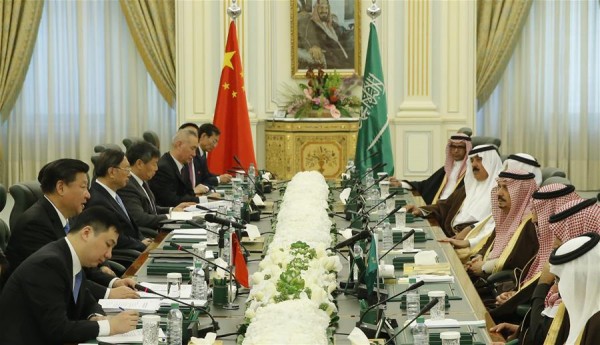

Follow us on:  
|


Chinese President Xi Jinping (2nd L) holds talks with Saudi King Salman bin Abdulaziz Al Saud (3rd R) in Riyadh, Saudi Arabia, Jan. 19, 2016 [Xinhua]
The Saudi monarch’s visit to China is part of the kingdom’s new initiative to boost economic and strategic cooperation with a number of Asian states.
With oil prices less than half of what they used to be in 2014 and Saudi Arabia registering significant budget deficits since then, Riyadh has sought an ambitious reform package under the title Vision 2030.
An external component of the reforms include looking for new trade and investment opportunities in the east.
Before visiting China, King Salman stopped in Malaysia, Indonesia, Brunei and Japan where he signed billions of dollars in investments between Saudi Aramco and local oil companies like Kuala Lumpur’s Petronas.
In China, the King pushed forward cooperation between Aramco and local oil giant Sinopec and is expected to have signed $65 billion worth of trade and investment deals before he leaves on March 18.
President Xi Jinping, who met with King Salman in Beijing, visited Saudi Arabia last year during which both countries elevated the level of their ties to a comprehensive strategic partnership.
Saudi Arabia is hoping to sign a free trade deal with China in the coming months.
Xi has also endorsed linking the Vision 2030 initiative with China’s Belt and Road project.
China’s One Belt, One Road initiative aims to create a modern Silk Road Economic Belt and a 21st Century Maritime Silk Road to boost trade and extend its global influence.
The ancient Silk Road connected China and Europe from around 100 B.C.
The 6,000-km road linked ancient Chinese, Indian, Babylonian, Arabic, Greek and Roman civilizations.
A map unveiled by state agency Xinhua shows the Chinese plans for the Silk Road run through Central China to the northern Xinjiang from where it travels through Central Asia entering Kazakhstan and onto Iraq, Iran, Syria and then Istanbul in Turkey from where it runs across Europe cutting across Germany, Netherlands and Italy.
The BRICS Post with inputs from Agencies